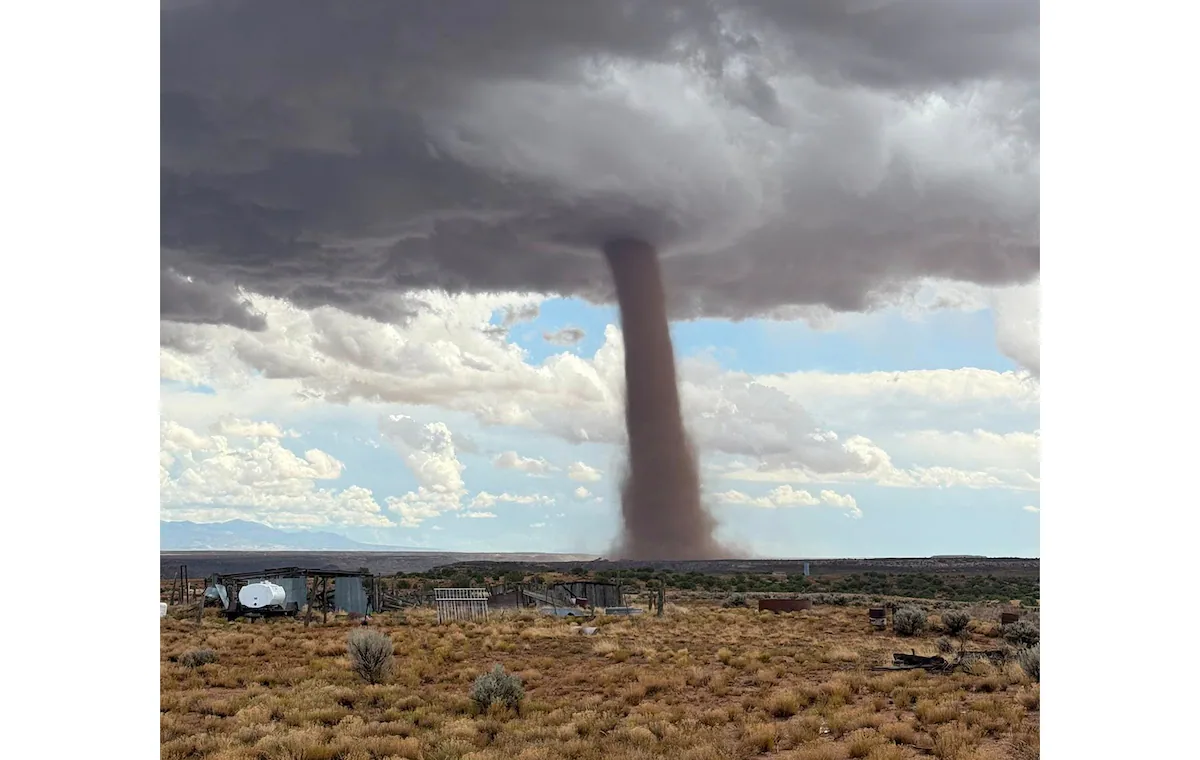
Chasity Light was lost in thought, watching her clothes spin quiet circles at the laundromat during her regular Saturday errand in Montezuma Creek when a panicked woman’s voice broke through.
“Who lives to the north? Does anyone live to the north?”
Light thought the woman maybe needed a lift and reflexively raised her hand.
“There’s a tornado forming there on top of the mesa,” the woman responded. “Is anyone at your house?”
Before she realized what she was doing, Light was in her Buick, barreling toward the storm and her husband, kids and parents.
Light, 39, has spent most of her life in the same southeastern corner of Utah, where a slim portion of the Navajo Nation sits like a crown atop the Arizona border. She is Diné, or Navajo, and her home is in McCracken Mesa; like many of the region’s rural places, it isn’t the name of a town but a landmark.
The remote desert area is made up of many raised mesas like the one by her house, alternating with deep rutted canyons. They’ve never had a tornado that Light can recall.
But as she raced toward her family, she could see it spinning parallel to the familiar cellphone tower on the horizon: A thick, gray funnel reaching down from the sky.
“That’s when I knew it was close to my home,” she said. “That’s when I knew it was real.”
Her hand shook as she called her husband, John Charles Jr., to warn him.
He’d been watching it, too, through a screened window — yards from their front yard, tearing through the hillside junipers and swirling up rusty sand. He didn’t think he needed to leave yet, but it was growing close.
Light sped along State Road 262, trying to beat it. Then, while they were talking, the clouds lifted and the spinning stopped. She pulled into the drive of their home just after noon.
It was only the first tornado of that day to touch down on the Navajo Nation.
An unusual storm for the Navajo Nation
Al Whitehorse, a Navajo man who, with a laugh, describes himself as 60 years old “plus some,” is worried about what the tornadoes could mean.
In his culture, a natural disaster is considered a sign of Mother Earth’s unbalance and distress. That’s even more the case, he added, when a disaster happens in an area that wouldn’t typically see that kind of event — like a tornado in Utah’s redrock desert.
The Navajo language doesn’t have a word that translates directly to “tornado.” Native speakers instead say “níłch’itsoh,” which means “the air/wind that is big.” Often, the same word is used for hurricanes, which are unlikely on the landlocked reservation.
The sovereign Navajo Nation is the largest American Indian reservation in the country at more than 27,000 sprawling square miles — larger than the size of West Virginia. It touches into Utah, Arizona and New Mexico with about 200,000 residents.
The area traditionally sees dust devils, which form from the ground up as high heat on the earth’s surface warms the air above. They are typically smaller and weaker, though they can also be destructive.
Tornadoes develop from the sky down. They form when warm and cold air combine. And they need moisture, which is why they typically accompany rainstorms.
“That’s just not something you ever see down here,” Whitehorse said of the Sept. 13 storms.
Without precedent, Whitehorse noted, there also isn’t a standard way of warning residents. The first National Weather Service alert didn’t go out until after the first tornado had already dissipated.
And on a reservation where many don’t have running water, a lot also don’t have cellphones to receive those alerts — or internet to check weather reports.
Whitehorse saw a friend of his, a deputy with the San Juan County Sheriff’s Office, drive past with his sirens on. The deputy stopped at as many houses as he could, going door by door, urging residents to leave.
It’s a miracle, Whitehorse believes, that no one on the reservation was injured by the tornado, though at least three structures were destroyed.
Many didn’t know which direction to flee. As Whitehorse tried to get away, for example, he ended up driving east in front of the second tornado’s path.
‘Everybody get out of here’
Louis Williams had just finished helping his river rafting company launch its latest trip of the summer when he went to pick up his standard reward: a cold root beer.
He opened the fridge at the small Montezuma Creek store and stared at the bottles, lingering a little longer in the cool air.
His clients, 23 students from Arizona, had been excited. The San Juan River was up from unexpected rain, and the typical southern Utah heat had faded a bit that cloudy morning.
“We’d been battling the sun all summer, so the shade was nice,” said Williams, 46, who is Diné and started Ancient Wayves River and Hiking Adventures in 2020 to offer Indigenous-led trips in the region.
It never occurred to him that those clouds could carry disaster. When the cashier screamed “tornado,” the word didn’t register. “What is that?” Williams thought.
He walked to the front of the store without his drink. Through the windows, the sky had turned so dark it almost looked like night. A thick funnel had formed, the second and stronger of the two to hit the area that day.
The cashier yelled, “What do I do? Should I close the store?,” but Williams didn’t know what to say. They and another customer went outside, where they found others, looking up.
One shouted, “We’ve got to go! Everybody get out of here!”
Williams listened, but like Whitehorse, he didn’t know which direction was safest. He thought of the group on the river and drove his Chevrolet toward them.
His choice led him west, where the tornado was coming from. Several people he passed gave him weird looks, waving at him to turn around. But Williams flashed them the peace sign. The funnel was bigger now.
At a trading post, he pulled over and hopped out. He couldn’t see his team on the river; they’d already rounded the bend. But the tornado was maybe a mile from him.
He watched it swallow and swirl juniper trees, sagebrush and sand as he debated what to do — call his co-worker, or wait until he knew they were in its path.
Then, Williams said, it seemed to veer northeast. His team was floating southwest.
“I watched it dance off into the distance,” Williams said. “And I was relieved, so relieved.”
He let out a breath he felt he’d been holding for hours, though the tornado lasted just less than one.
What was destroyed
Curtis Yanito walked through the wreckage in disbelief. Homes that stood the day before, where families gathered for love and mutton soup, were completely wiped out.
All that was left of one house was its cement foundation.
A mobile home that sat next door was reduced to cinderblocks. Its little red staircase out front now leads nowhere.
A third residence, where a couple had been living in a trailer, was also destroyed, crumpled like a soda can.
Yanito, the Navajo Nation Council delegate for the region of Utah hit by the tornadoes, says those three residences are considered total losses. The Navajo Nation Police Department has reported the same.
“I’ve never seen anything like this,” Yanito said. “These folks lost everything.”
All the people affected are part of the same family group that had been living near each other, Yanito said. He provided a copy of the assessment he drafted with the Navajo Department of Emergency Management.
The families also reported the tornado shattered their cars’ windows. Their sheep and cow corrals were torn apart, animal trailers wrecked. Several barns were leveled. And equipment was carried off in the wind, including the 800-gallon blue barrels they used to transport water from nearby refill stations to their homes.
Additional homes nearby also saw damage, including tears along their roofs. A number of power poles were knocked down “like they were toothpicks,” added Bill Todachennie, the vice president for the Navajo chapter house in nearby Aneth.
Power has since been restored, Todachennie said. Both he and Aneth Chapter House President Carma Claw expect more damage to be reported in the coming weeks.
“It just tried to lift these houses straight up,” Claw said.
Meanwhile, most of the livestock that wandered away have returned, she said.
Yanito, who lives in Bluff, said it was terrifying to see the destruction and talk to the families.
The couple who lost their mobile home, he said, were tribal elders. The wife had recently had heart surgery, and her husband has been taking care of her. They’ve been staying at a hotel since.
But other family members, Yanito said, have wanted to remain on their property.
Luckily, he said, all were away from home on Saturday and weren’t injured.
Yanito recalled speaking to another man who refused to leave as the tornado barreled toward him. Instead, he stood on his front porch and started talking to it.
“This is where I live. This is my home,” Yanito said the man told the tornado. “You need to go a different route.”
The tornado kept rotating but stopped approaching, Yanito said. In traditional Navajo culture, Yanito said, people believe in “Wind Way.” It’s a blessing that can then allow them to communicate with weather or heal from it.
The man, he said, had previously done that ritual and wasn’t afraid. Yanito believes it worked; the storm eventually turned around and disappeared.
Call for a ceremony
Whitehorse called the tornado he experienced a “force,” saying the spiral felt alive.
He is calling on Navajo leaders to hold a formal ceremony to cleanse the area and help heal.
“Mother Earth is revered in our tradition, and ceremonies should be held to restore her,” he said.
Whitehorse had been on his way to Cortez, Colorado, for hay for his ranch when he first saw the funnel form. And like many others that day, he said it seemed to dissipate and then reform several times. He and his wife counted at least 10, as did Tornado Path, a real-time website that tracks storms.
He spent the night in Durango, Colorado, and tracked back again along the storm’s path on his way home. The earth, he said, looked dead where it touched down, the plants and shrubberies completely cleared out.
Scott Rozanski, the warning coordination meteorologist for the National Weather Service station in Grand Junction — which covers the eastern half of Utah — tracked and assessed the unusual Utah storm. He said there were two distinct tornadoes, with preliminary reports suggesting an estimated peak wind speed of 120 miles per hour.
That would categorize it as a EF2, the second of five levels (which go up to 200 mph in the worst storms). That’s the same as the tornado that hit downtown Salt Lake City in 1999, causing one death and 80 injuries and destroying 34 homes.
Rozanski said Utah averages about two tornadoes a year, but most are small and not in highly populated areas. It’s strange, he added, to see one in the especially dry, craggy Four Corners region.
That topography might have contributed to why it appeared the tornado was stopping and starting, he said. Tornadoes need flatter ground, so canyons and valleys might make it look like it’s dissipated when it hasn’t.
Rain can also fall in front of it, making the spiral hard to see.
Kayla Sue Kaniatobe, who lives northeast of Montezuma Creek, filmed it live on Facebook. “It looks like a Hershey’s Kiss upside down,” the 29-year-old commented on one of the videos, which she counted as the fourth touchdown she’d witnessed.
You can see the changes she’s describing in the atmosphere as the storm gains strength. The sky is clear for a moment, then gets dark again. Juniper trees hold still, then wind whips through them. She also described the air being stifling hot, then suddenly chilly.
Her family had been gathering for a birthday celebration, and it was aunts and uncles headed north from Monument Valley who alerted Kaniatobe and her parents before they received any notifications on their phones.
Rozanski said his office issued a warning as soon as a tornado was confirmed. Prior to that, it had sent out a severe weather alert, noting tornadoes were possible.
When Kaniatobe’s family finally heard the beep of the tornado warning at 12:46 p.m., the second funnel seemed to be spiraling away.
“A confirmed tornado was located 7 miles northeast of Montezuma Creek,” the warning read, “or 22 Miles southeast of Blanding, moving northeast at 10 mph.”
‘Chilled in my bones’
Nikki Black also thought the initial notifications she received were vague. The first didn’t even mention the county. But when the next specifically listed “Montezuma Creek,” she texted her husband, who was out pulling gas lines north of the town for a trucking company.
Lavar Black, 47, didn’t hear his phone ding with her message as he worked by Elk Petroleum. He was so focused, in fact, that he didn’t see the tornado moving toward him until, he said, it was about a half-mile away.
He only looked up, he said, because he felt “chilled in my bones.” At first, the gray column looked like smoke, and he thought it might be a house fire. He kept looking and refocusing; it took minutes before he said the word “tornado” came to mind, quickly followed by “run.”
He bolted to his truck and called his boss. “It was just coming straight toward me,” he said as he tried to put some distance between himself and the funnel.
Black said there was lightning and thunder but no rain. After he’d driven for about a minute, he stopped to take pictures; in one, the size of the funnel dwarfs his big rig. First responders passed by and screamed at him to get out of the area.
“You could really hear the grinding of the tornado. It was unreal,” he said. “… It was majestic and beautiful, but it was terrifying at the same time.”
Black said he wasn’t initially scared, but as he’s reflected more on it, he said he feels like he wouldn’t have had anywhere to go if the funnel had crested the hill in front of him.
His wife, he added, has lovingly chided him to pay more attention at work — and not take selfies with natural disasters.
Light, who drove toward the tornado to get her family, said she’d do it again.
She was able to retrieve her laundry later, but next time, she doubts she’ll find herself easily distracted while watching her wet clothes swiftly swirl in the machines.
How to help
The Aneth Chapter House is accepting donations to help those most affected by the tornado. President Claw said that includes material goods for the families who lost their houses, as well as nonperishable food and water.
Vice President Todachennie mentioned the need for dog food, too. And he said the families will need to replace appliances that had been in their homes, including washers, dryers, stoves, fridges and water heaters.
Donations can be delivered to the chapter house’s warehouse at 19 Fairway Loop in Aneth.
Claw recommended, though, that folks reach out first by email at aneth@navajochapters.org to coordinate, so there isn’t duplication or unnecessary items brought there.
Miss Gallup Inter-Tribal Indian Ceremonial Queen and Miss Utah Navajo have also teamed up to collect food and toiletries. They can be messaged for more information on their Instagram pages (@gallupceremonialqueen and @missutahnavajo).
The tribe is asking for help with repair on the damaged homes, including both labor and building materials, such as plywood, lumber and window replacements (for houses and cars).
The Navajo Nation typically doesn’t allow for online financial donations, as it’s cautious against scams. Council Chair Yanito said money is only accepted if it’s given directly to the family or person in need.



